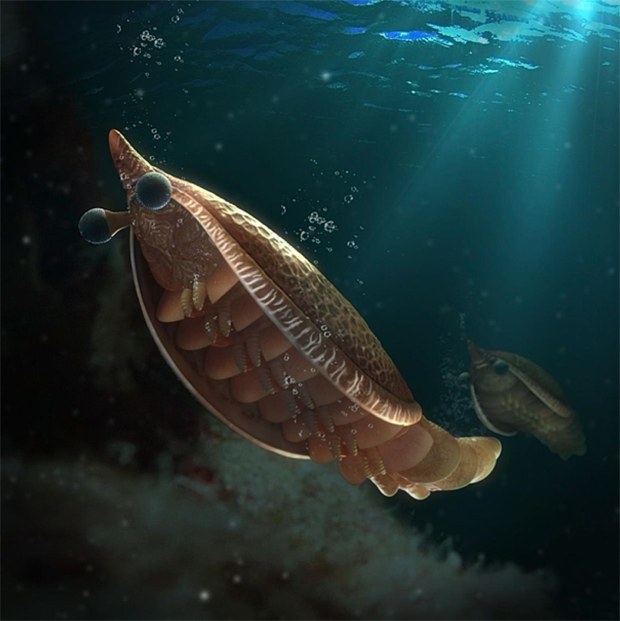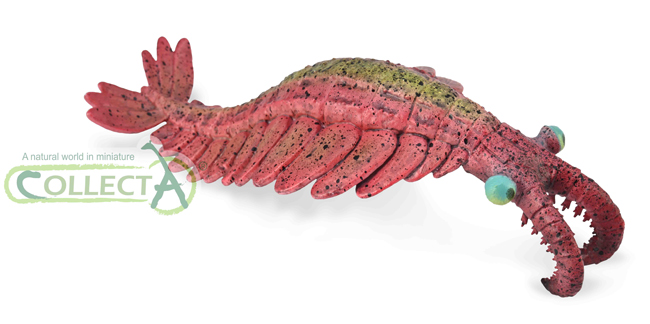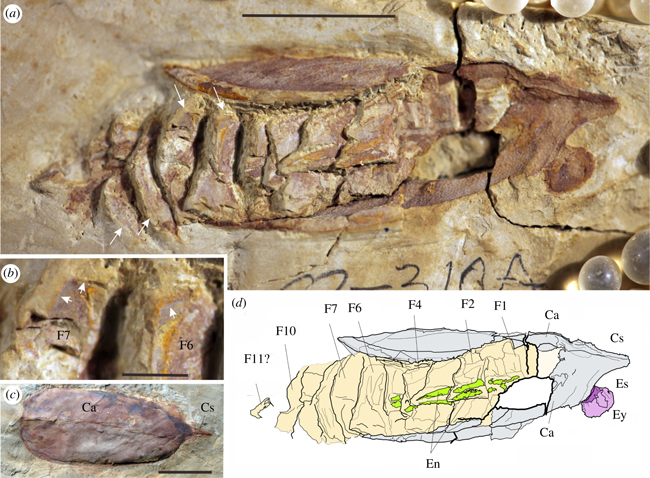New Research Giving the Arthropoda a Leg Up
A University of Manchester researcher in collaboration with a team of international scientists from China, Sweden and Switzerland has helped invertebrate palaeontologists to resolve the puzzle of how arthropods evolved gills. Dr David Legg from the Department of Earth, Atmospheric, and Environmental Sciences and his co-authors have published a scientific paper this week that describes a new genus of ancient marine arthropod from the Chengjiang biota of Yunnan Province, China. The newly described Erratus sperare swam in a shallow tropical sea some 518 million years ago (stage 3 of the Cambrian). At around 3 centimetres in length, it was no giant, but it represents a giant leap forward in the evolution of the Arthropoda.

A life reconstruction of the Cambrian Erratus sperare which has helped palaeontologists to improve their understanding of the origin of gills in the Arthropoda. Picture credit: University of Manchester.
Picture credit: University of Manchester
The Evolution of Biramous Limbs
Extant water dwelling arthropods and their extinct counterparts such as the trilobites have biramous limbs, legs that have two distinct parts or branches – one for breathing and one for walking. The inner branch is known as the endopod and the outer branch is called the exopod, together these two branches form the marine arthropod limb.
How such specialised limbs evolved was a mystery. Some of the earliest fossil arthropods, like Anomalocaris, had swimming flaps that may have doubled as gills, but until now researchers didn’t know how arthropods made the jump from these specialised flaps to the biramous limbs of modern arthropods.

The CollectA Anomalocaris model. A fantastic replica of an early apex predator. The CollectA Anomalocaris (Other Prehistoric Animal Models).
The picture (above) shows a model of an Anomalocaris, a large Cambrian predator. This model is part of the CollectA range.
To view the CollectA range of prehistoric animal figures: CollectA Prehistoric Life Models.
Erratus sperare – A Transitional Form
Erratus sperare fossils come from the UNESCO World Heritage Site located in Yunnan Province, China. The Maotianshan shales exposed in Chengjiang County preserve a record of a Cambrian marine community that existed several million years before the Burgess Shales of British Columbia were laid down. The highly fossiliferous strata have yielded at least 196 different species, with both hard parts and soft tissues preserved.
E. sperare appears to be a transitional form, it provides a missing link between arthropods that used specialised flaps such as Anomalocaris and arthropods with biramous limbs. It has both legs and flaps.

Erratus sperare gen. et sp. nov. from the early Cambrian (Series 2, Stage 3), Chengjiang Lagerstätte, China. The fossils are approximately 518 million years old. Photograph (a) NWUS92-310, specimen formerly referred to Isoxys auritus note the carapace with short anterior spine and covering the seven most anterior body segments; the flap margin without setae (arrows); (b) details of flap 6–7; note the smooth margin. XDBZ102 (c), the complete carapace (Ca) of E. sperare in dorsal view, showing anterior spine and straight posterior margin; (d) line drawing of (a) showing cardinal spine (Cs), ventral eyes (Ey) with stalk (Es), and flaps 1–11; the ventral endopods (En) are present in the anterior trunk. Scale bars, 2 mm for (b) and 1 cm for others. Picture credit: Fu et al.
Picture credit: Fu et al
Explaining the significance of this fossil discovery, Dr David Legg commented:
“Fish aren’t the only organisms that have gills! Arthropods have gills too… they just have them on their legs. When it came to arthropods, however, we just weren’t sure where these gills came from. Thanks to this new fossil, Erratus sperare, we now have a much clearer idea. These gills also probably went on to evolve into the wings of insects and the lungs of terrestrial arthropods like spiders so were a very important innovation.”
Everything Dinosaur acknowledges the assistance of a media release from the University of Manchester in the compilation of this article.
The scientific paper: “The evolution of biramous appendages revealed by a carapace-bearing Cambrian arthropod” by Dongjing Fu, David A. Legg, Allison C. Daley, Graham E. Budd, Yu Wu and Xingliang Zhang published in Philosophical Transactions of the Royal Society B.
Visit the Everything Dinosaur website: Everything Dinosaur.

